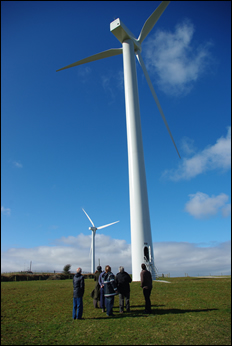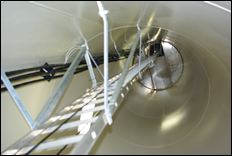Many thanks to VentnorBlog writer, Wendy Varley, for her report of a visit to see wind turbines in action at Roskrow Barton in Cornwall last week. It’s a long report, but worth the read if this is an area you have an interest in. Ed
 My visit to Cornwall Light and Power’s wind turbines at Roskrow Barton on a hilltop near Penryn in Cornwall wasn’t just for VentnorBlog’s benefit.
My visit to Cornwall Light and Power’s wind turbines at Roskrow Barton on a hilltop near Penryn in Cornwall wasn’t just for VentnorBlog’s benefit.
From where I live, wind turbines on Cheverton Down would be highly visible, and I’ve paid careful attention to both sides of the debate about whether three 125m turbines (tip-height) should go there.
There’s already planning consent for three smaller (tip-height 52m) wind turbines at the site dating back to 1995, updated 2003. If the application for larger turbines is turned down, CLP could install old turbines. But they wouldn’t be anything like as efficient as the larger models.
Never having been up close to wind turbines, I was keen to witness for myself how they operate, look, and sound. Are they the humming monstrosities that some opponents suggest they are, or silent and graceful workhorses?
Joining Me On The Visit
Also checking them out were Ray Harrington-Vail from the Isle of Wight’s Footprint Trust, and Hugh Walding (the IW Friends of the Earth co-ordinator.
We met up with representatives from CLP in sight of the turbines at the Cornwall campus of the University of Exeter, which runs a degree course in renewable energy.
Students from the course research the wind turbines, and have access to all the data on their performance.
A local farmer had reported seeing lightning strike one of the turbines during storms the previous day, but Steve Allen from CLP did not seem overly worried on hearing the news. Wind turbines are designed to cope with lightning strikes, and will automatically shut down and run checks before re-starting a few minutes later if everything’s okay, which is what the data showed had happened. There was no damage, and only momentary interruption to supply.
In the Lab
We arrived at the lab to find senior lecturer Dr Dean Millar explaining to a group of visiting sixth-formers from Exeter (all boys I noticed), how wind turbine blades work: the flat of the blades face the wind so that they resist it and flex back towards the tower as they turn.
He mentioned a rare wind turbine collapse in Scotland when a turbine failed to cut out in strong winds and a blade flexed so much that it collided with the tower causing it to crumple.
Neil Harris, Chief Executive of Cornwall Light and Power, quickly chipped in to say that it had happened in hurricane force winds, and that although wind turbines cut out in winds of 25m/s (56mph) they are designed to withstand winds of up to 70m/s (156mph) in the event that they fail to shut down.
Dr Millar went on to talk about the very small risk to birds from modern wind turbines (“half a bird per turbine per year”), and compared it to the far bigger threat from cars, or domestic cats (apparently an estimated 100 million birds a year are killed by cats).
Ray Harrington-Vail interjected that climate change poses a major risk to birds and bats.
Alternative Renewable Energy
Dr Millar touched on other forms of renewable energy, as the college is researching moorings for Cornwall’s £30 million Wave Hub project, which aims to find the best methods to harness wave energy.
“You can appreciate how difficult it is to anchor big wave energy devices in the strongest currents,” said Dr Millar, indicating a gargantuan mooring chain in the middle of the lab.
The SeaGen Ulster tidal project has been looked at with a view to its suitability for off St Catherine’s Point, but as that site is home to a natural reef and a wartime munitions dump, it is less than ideal.
Dr Millar emphasised that research and development into wave and tidal energy is twenty years behind wind turbines, and that wind turbine design has been honed over many years, and is proven and available now.
Neil Harris said that the technical issues that objector groups raise about wind power have been repeatedly dismissed at planning enquiries, but that every time a new planning application goes in “we have to keep on justifying it”.
 Dr Millar recalls how locals opposed the Roskrow Barton development (which went to appeal), “But since the turbines went up they’ve not said anything.”
Dr Millar recalls how locals opposed the Roskrow Barton development (which went to appeal), “But since the turbines went up they’ve not said anything.”
Steve Allen adds that some opponents of the turbines have now come back to CLP saying they like them.
Neil Harris compared the proposals for Cheverton Down with another of CLP’s developments, Goonhilly Downs in Cornwall: “Those turbines are in an AONB [Area of Outstanding Natural Beauty] and have been adopted by the community.”
Dr Millar has attended wind farm enquiries, and in his opinion objection boils down to two things: people are interested in house values (not a reason for refusal of a planning application); and “local folk sometimes feel it’s someone else coming along and taking our wind”.
“There’s nothing to stop someone forming Isle of Wight Light and Power”¦ if they’re willing to make the investment,” adds Neil Harris.
What Happens When the Wind Stops Blowing?
I ask Neil about the point people make on the Island that during the cold but still weather at New Year wind turbines would not have been much use.
“They’d be right, but overall it’s been a very good wind year,” he says. In their first year of operation the Roskrow Barton turbines have matched their predicted output, and have been producing energy 90% of the time.
“Some energy, but not at full capacity?” I ask.
No, but with an average windspeed of 7.5m/s at the site, the two turbines have produced enough electricity to power more than 1000 homes. (CLP predict that the three larger V90 turbines at Cheverton would power between 4500 and 5000 island homes.)
Dr Millar explained that the overall 30% efficiency of wind farms compares well to other forms of conventional energy such as coal-fired power stations.
Under The Turbines
From the university campus we walked up the track to the wind turbines. It was a bright and blustery March day, and I heard nothing other than the wind and a passing car until I was 70 metres away, where the swoosh of the turbine blades passing the towers was just audible.
Even right at the base of the turbines they are very quiet. Here’s a short recording I made at the base of one of the towers.
The main noise you can hear is the general background noise of the wind. Over that you can hear a rhythmic swish of the turbine as the blades pass the tower. [audio:http://otw-audio.s3.amazonaws.com/roskow-wind-turbine-noise.mp3]
John Mills, head of construction management at CLP, showed us the nearby control room (in Cheverton’s case it would be down in the farm buildings), which houses a large computer, and a control panel from where the turbines can be adjusted or stopped completely. We were shown how by turning the blade edges to the wind the turbine acts as an air brake and gradually slows to a halt.
 Inside the Tower
Inside the Tower
Donning hard hats, we headed inside the turbine tower itself (picture right by Ray Harrington-Vail).
There’s a ladder up the inside for maintenance work. John explained how the gearbox in the nacelle (behind the blades at the top of the tower) amplifies the power from the slowly rotating blades, before it’s converted by the generator into electricity, which flows through cables down the inside of the tower and underground to the nearest substation.
Monitors at the base of the tower showed the wind speed (which was fluctuating between 7.5 and 10m/s) and power generation.
I felt at ease standing by the turbines, though I had to bear in mind that at 72m to the tip they’re 60% of the size of those proposed for Cheverton.
Dr Millar had compared people’s perceptions of wind turbine size to the scene in Father Ted when Ted explains to Dougal that a miniature cow in the distance isn’t really miniature, it’s just further away.
But for anyone walking the Tennyson Trail there’s no doubt that they would have a fairly close encounter with some pretty large structures.
But a public footpath runs right across the site at Roskrow Barton, within feet of the turbines, and from the hilltop there’s a spectacular view of Cornwall. Maybe the turbines are simply a point of interest on the route.
Other Wind Turbines
On the horizon I could make out other wind farms – Bears Down and Carland Cross – on the north Cornish coast. I can’t claim they’re a blot on the beautiful landscape. They’re barely noticeable. But although Cornwall is more familiar with wind farms, there are objectors there, too.
Later, when I Googled Carland Cross, I noted some opposition to plans to replace the existing 17-year old turbines with ones with a tip-height of more than 100m.
Given that we have no giant turbines at all in this part of the country yet, it’s perhaps no wonder that people are concerned about their potential impact on the landscape.
But there has been a discernible shift of opinion since the plans for wind turbines at Wellow were rejected in 2006. Then, just 18% of the 2312 respondents were in favour. This time it’s a third (612 of 1940).
Ray Harrington-Vail pointed out that a consultation on the Island’s AONB has been taking place, and the responses on that have been in the tens, not the hundreds, suggesting that people are perhaps not quite so fired up about the landscape as the wind turbine debate suggests. He openly supports the wind turbines, and believes that “People might change their priorities once the lights start going off.”
For myself, I am largely reassured about their performance, certainly about their quietness, and in terms of the visuals, while I still can’t entirely picture how they would look in the Island’s landscape, they’re undoubtedly more attractive – and clean – than the coal mines and spoil heaps that used to dot the Yorkshire countryside of my childhood.
Balance
As ever, we try to present a balanced view of subjects. We’ve made considerable effort to get the views of the main opposition to wind farms on the Island, ThWART (The Wight Against Rural Turbines), but to date we haven’t heard from them after they agreed to take part in an interview.


